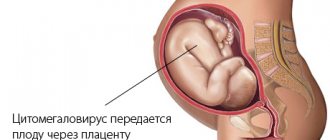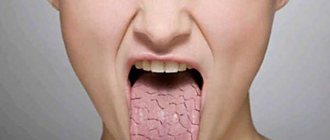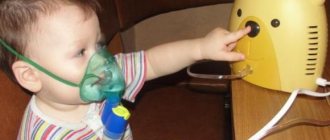Features and mechanisms of disease development
The etiological agent of the infection is the RNA genomic rubivirus, which belongs to the togavirus family, similar to the measles pathogen. A person can only become infected from a person by an aerogenic mechanism.
A sick person or simply a carrier of the virus is contagious during the final week of the pre-illness stage (incubation period) and for another 3 or 4 days from the onset of the first rash. The rubella virus is practically unstable in the external environment; its death occurs at high temperatures and exposure to UV rays, while at the same time the pathogen persists for a long time when frozen.
It has an affinity for epithelial, nervous, embryonic and lymphoid tissues, which explains the main clinical manifestations of the disease.
Entering the human body, the virus is adsorbed on the epithelium of the mucous membrane of the respiratory tract, and then, breaking through the hematological barrier, penetrates the blood. Viremia develops (circulation of viral particles in the bloodstream), due to which the lymph nodes become infected. Viral replication leads to the development of lymphadenopathy.
In response to the massive proliferation of infection, the body begins to synthesize antibodies aimed at combating viral particles. The first rashes indicate their appearance in the blood and the completion of the viremia phase.
In addition to the acquired form of the disease, congenital rubella is isolated. Infection of the embryo in this form occurs transplacentally and leads to severe congenital anomalies, often incompatible with life.
There are 4 clinical periods of disease development:
- Incubation (on average 16 days);
- Prodrome (days);
- The height of the disease (up to 3 days of mild fever with rashes and runny nose);
- Recovery.
Routes of transmission of rubella
The cause of the disease is a virus that has entered the human body. It is very sensitive to ultraviolet rays and dies almost instantly when there are changes in ambient temperature or changes in humidity levels. Routes of transmission of rubella:
- airborne - common, that is, you can become infected from a sick person and it does not necessarily require close contact;
- transplacental - the virus is transmitted from a sick mother to the fetus, crossing the placental barrier.
It is noteworthy that outbreaks of rubella occur every 5-7 years and the peak of this disease occurs in the spring and summer periods. Despite such frequent epidemics, they do not pose a danger to the majority of people around them, since modern medicine has various preventive measures. Knowing how rubella is transmitted, you can promptly close a preschool or school institution for quarantine and protect the majority of children from infection.
First signs
Rubella in children, the symptoms of which appear on average 2 weeks after contact with an infected person, has different manifestations.
They are as follows:
- The acute onset is usually low-grade fever (rarely up to 38°C);
- Catarrhal syndrome - profuse rhinorrhea, sneezing, cough without sputum, sore throat;
- Small spotted exanthema;
Rubella in children begins with small-spotted exanthema. These are the first symptoms and treatment should be started immediately, without delay.
- Enlarged posterior lymph nodes (cervical and occipital).
The last symptom is especially typical of the disease. On average, 5 days before the appearance of exanthema and after it for 2 weeks, the lymph nodes remain enlarged. In this case, palpation is often extremely painful.
Symptoms
What does rubella look like in children? The insidiousness of a viral disease is a long incubation period with mild symptoms. The rash has not yet appeared on the body, but the sick child is already generously “sharing” the virus with others. Even adults can become infected if for some reason they were not vaccinated at 1 year of age, revaccinated at 6 years of age, and then in adolescence (for girls). Boys aged 15–17 years are given revaccination against a dangerous disease – mumps.
Clinical picture and signs of rubella in a child:
- After contact with a virus carrier, the infectious agent enters a healthy body, multiplies quickly, and gradually penetrates through the bloodstream into various organs and systems. The incubation period lasts 3 weeks;
- the first signs of the disease appear, which bear little resemblance to rubella: excessive irritability, moodiness for no apparent reason, drowsiness, lethargy;
- After the virus spreads throughout the body, the lymph nodes in the groin, under the jaw, and in the armpits become slightly swollen and hardened. After two to three days, the signs move to the back of the head: the lymph nodes also enlarge in this area;
- the temperature rises, often up to 38 degrees, the child’s health worsens, and the child develops a cough. Children suffer from attacks several times a day;
- Nasal congestion, severe swelling of the mucous membranes is another symptom of rubella. It is characteristic that there is practically no discharge from the nasal passages;
- rashes appear all over the body after 2 days. Initially, flat spots up to 3 mm in size are localized in the area of the nasolabial triangle, the front surface of the neck, near the ears;
- a day later - two round or oval spots of red color with a pinkish or orange tint appear on the shoulders, back, spread to the stomach, thighs, and cover the groin;
- the body becomes covered with spots for 3 to 7 days, then the rashes turn pale and gradually disappear without a trace;
- other signs disappear: the condition returns to normal, swelling of the mucous membrane subsides, there is no cough, the child is actively eating;
- The disease in children is mild. With bed rest and symptomatic treatment, complications are rare. If the child is very weak, the therapy is carried out incorrectly, the virus affects parts of the brain, throat and nasopharynx. Possible consequences of an untreated infection are meningitis, otitis media, encephalitis. Sometimes arthritis and sore throat develop.
READ ALSO: Infectious disease from the group of respiratory viruses - adenoviral infection in children: symptoms, treatment, routes of transmission and infection, preventive measures
What rubella looks like: photo
A distinctive feature of the disease is a rash. It spreads during the first 24 hours (less often in the first 2 days) quite quickly, resulting in the feeling of a one-time rash all over the skin. However, exanthema with rubella is characterized by a sequence of sprinkles.
The rash spreads from top to bottom, first covering the face, behind-the-ear areas, scalp, and then down to the torso and limbs. The elements cover the flexor surfaces of the joints, the back and buttocks especially abundantly. The palms and feet remain clean.
In most patients, the exanthema is small in size and morphologically represented by a spot. Only 5% have elements reaching 10 mm and are considered large. Even less common are maculopapular rashes. The shape of the elements is round or oval, pale pink, not prone to merging.
The rash is located on the unchanged skin and does not rise above it. During diascopy, the spot turns pale or even disappears, which indicates its inflammatory nature.
Already on the 1st day of the disease, a rash appears on the mucous membrane of the soft palate in the form of a faint enanthem (Forchheimer's spot).
The duration of exanthema syndrome is on average 2-3 days. The rash goes away without a trace, leaving no traces in the form of pigmentation or peeling.
Clinical manifestations, symptoms of rubella
At the onset of the disease, there is a slight sore throat, runny nose, enlarged cervical nodes, lacrimation, fever, headache, aches in muscles and bones.
Already on the first day, a rash appears on the skin - the main distinguishing sign of rubella. These are pink or red spots of a round or oval configuration. At first, the rash covers the upper part of the body: face, ears, neck, head, then it moves down and soon covers the entire body. Most of the spots are located on the back and in the gluteal region. The period of rash is several days, from 1 to 4.
As a rule, rubella is mild in children and they usually carry it on their feet. Adults get seriously ill and take longer to recover; they are more likely to suffer complications from the disease.
Symptoms of rubella in children
According to the time of occurrence, rubella is divided into two variants - congenital and acquired. In turn, the acquired disease is divided according to its course into typical and atypical forms.
Typical form of acquired rubella
This form of pathology has a classic development pattern. According to the severity of the clinical course, rubella is divided into mild, moderate and severe. Depending on the presence of complications, it can be classified as complicated or uncomplicated.
Uncomplicated typical rubella has a fairly mild course and is characterized by:
- incubation period from 11 to 22 days;
- lymphadenopathy approximately 5 or 6 days before clinical manifestations;
- onset, as a rule, without a prodrome (occasionally, mild malaise and cephalgia are possible);
- the first manifestations are in the form of a typical small-spotted, roseate rash with a characteristic staged rash;
- in the period of exanthema, the presence of fever for up to 3-4 days (figures up to 38-39oC);
- the presence of enanthema on the mucous membranes.
In addition to the rash, a distinctive feature of typical rubella is catarrhal syndrome. In the vast majority of cases (about 90%), it manifests itself as pharyngitis, and is often combined with a runny nose (on average in 70%). Patients often complain of a dry, unpleasant cough, a feeling of rawness and a sore throat.
Atypical form of acquired rubella
Symptoms of the atypical form of rubella in children are very scarce.
Clinical manifestations include:
- minor inflammatory phenomena on the mucous membrane of the respiratory tract;
- moderately pronounced enlargement of lymph nodes;
- no rashes.
In the diagnosis of this form of the disease, the fact of contact with an infected person plays a decisive role. This is especially important to know when diagnosing rubella in pregnant women.
Congenital rubella
The course of the disease in utero differs markedly from its acquired form. For congenital rubella, a triad of symptoms is pathognomonic (Gregg's triad - the author who first described this, the most common set of manifestations of intrauterine disease).
This includes cataracts, deafness and various heart defects (ventricular septal defects, absence of fusion of the ductus arteriosus and damage to the pulmonary trunk in the form of stenosis). But often, among the “typical” manifestations of congenital rubella, others are distinguished (the so-called “extended” triad).
These include other eye lesions, diseases of the central nervous system, blood system, heart, and musculoskeletal system:
- cataract, retinopathy, underdevelopment of the eyes (microphthalmia), inflammation of the choroid;
- mental retardation, developmental delay;
- thrombocytopenic purpura;
- hepatosplenomegaly;
- myocarditis;
- various lesions of the skeletal system.
Types of rubella
Depending on the route of infection, rubella in adults and children is divided into two types:
- acquired rubella - occurs in a wide variety of forms, is accompanied by the appearance of a rash on the body, but may also have an atypical clinical picture of development, in which a rash does not form. In addition, in 30% of cases there are no symptoms of rubella at all, which greatly complicates the correct diagnosis and provokes the spread of epidemics. Usually the disease occurs in a mild or moderate form, and patients are treated at home. Hospitalization is indicated only in the event of severe complications, which, however, are extremely rare;
- congenital rubella is much more serious than acquired infection. This applies to both manifestations and possible consequences, among which we can particularly note damage to the nervous system, heart defects, disturbances in the functioning of the eyes and hearing organs.
In connection with the above, I would like to make one significant remark: rubella in adults is quite rare, since the vast majority of people become ill in childhood, and the resulting immunity lasts for life. At the moment, at least 85% of women are immune to infection by the time they reach reproductive age.
The difference between rubella and measles and scarlet fever
The etiological agents of measles and rubella are quite similar to each other, which leads to a similar clinical picture of the diseases. This is especially true for the incubation and prodromal periods - the onset begins on average 10-20 days after contact with an infected person, the prodrome in the form of a minor intoxication syndrome.
The differences become noticeable from the first clinical manifestations. With measles, catarrhal syndrome comes to the fore, while with rubella it is insignificantly expressed and inferior in degree of manifestation to exanthema syndrome. Pharyngitis and rhinitis with measles are often combined with conjunctivitis.
The pathognomonic symptom of measles is the presence of Belsky-Filatov-Koplik spots. These are small, grayish-white pinpoint rashes framed by a hyperemic rim. They are located on the inner surface of the cheeks opposite the small molars. They appear a day before the rash, do not tend to merge, and are not removed when scraped with a spatula.
They represent necrosis of the epithelium of the mucous membrane. There are spots for up to 3 days. The main differences relate to the stage of the rash.
The difference between the measles rash is that it:
- occurs 3-4 days from the onset of the disease against the background of a repeated increase in temperature;
- maculopapular, tends to merge;
- spreads over 4 days from top to bottom, starting from the scalp;
- present on the mucous membrane of the entire oral cavity, and not just on the soft palate, as with rubella;
- turns into pigmentation and pityriasis peeling in its outcome (not simultaneously, but similar to the variant of appearance - from head to extremities).
The duration of the exanthematous period for measles is about 1.5 weeks versus several days for rubella. Other differences in measles include the absence or less pronounced lymphadenopathy.
Features of rubella in children under one year of age
Rubella is considered a disease of childhood. As a rule, children can get it from the age of 2 years. The first year of a child’s life is protected by antibodies that were passed to him at birth from his mother, so he is less vulnerable to many pathologies.
Children under 1 year of age in most cases suffer from congenital rubella. The clinical picture of the disease is represented by the classic Gregg triad. In addition, hydrocephalus and encephalopathy may be present.
If a pregnant woman has suffered the disease after the completion of fetal organogenesis, the clinical picture will be characterized by fetopathies in the form of hemolytic anemia, hemorrhagic syndrome against the background of thrombocytopenic purpura, damage to the liver, bones (open fontanelles, cleft palate and others), lungs in the form of interstitial pneumonia.
Somewhat later, other defects may be discovered, because often in the first months of life it is not possible to establish all the pathologies.
Children are born with congenital rubella with insufficient body weight and short stature (microsomatic type of physical development). They often lag behind in physical and mental development. Within six months, most symptoms may disappear, with the exception of severe abnormalities and defects.
Possible complications
Complications from rubella in children are rare and usually such symptoms are caused by the addition of a secondary infection. But there are also specific complications.
These include:
- Joint damage in the form of arthritis is more common in girls, on average a week after the rash, and is characterized by swelling and hyperemia of the skin in the affected area, pain. Symptoms disappear within a week.
- Disorders of the central nervous system - the membranes of the brain, spinal cord and brain matter are affected. Clinically manifested by meningoencephalitis, encephalomyelitis and panencephalitis. They develop on the 5th day and begin with repeated fever and the appearance of general cerebral and focal symptoms.
Prevention of rubella
The main means used to prevent and eliminate negative effects on health is vaccination.
Vaccination against rubella is carried out from the age of 12 months in children, revaccination by 6 years, and to prevent possible congenital rubella, vaccination of girls aged 12-13 years is carried out.
Usually, vaccination against rubella is done together with vaccinations against mumps and measles; vaccination is carried out with a vaccine manufactured in the European Union. After vaccination, from the 5th day, temporary ailments in the form of a runny nose, cough, skin protrusions, and joint pain are possible. Human immunity develops in the third week after vaccination and persists for 20 years.
What tests are performed for rubella?
To establish a diagnosis of rubella, a set of clinical and epidemiological data is required: the presence of a burdened epidemiological history (contact with a sick person or carrier of the virus), typical clinical symptoms and certain changes in laboratory parameters. Laboratory tests play a special role in the case of an atypical disease.
For the diagnosis of rubella, the following are important:
- General blood and urine tests;
- Analysis of cerebrospinal fluid if there is a suspicion of damage to the central nervous system;
- According to indications, electroencephalography (EEG) and ECG methods can be used;
- Express diagnostics is performed using immunological methods, for example, RIF (allows you to detect antibodies to an infectious agent in the patient’s serum);
- Longer immunodiagnosis includes the hemagglutination inhibition test (HIT), compliment fixation (CFI) and other studies. In this case, not just the presence of antibodies is examined, but the increase in their titer, which indicates the activity of the infectious process.
Vaccination
This is the most effective measure for preventing rubella. Since 2001, its use has been practiced in children from the age of two. It is part of a multicomponent vaccine that has proven itself in practice. Typically, three components are used in traditional vaccination; these are weakened measles, rubella and mumps viruses. The first vaccination is given a year, the second after 6 months.
Thanks to the vaccine, the incidence of illness in childhood has decreased significantly. The injection is placed under the skin, immunity develops within 20 days and lasts for more than 20 years.
Women are recommended to take a blood test while planning pregnancy to determine the level of antibodies to the disease; according to the study, if there is a lack of antibodies, secondary vaccination may be offered.
Treatment of rubella in children
Rubella in children, the symptoms of which are considered quite typical for an infectious pathology, is a disease for which etiotropic therapy has not yet been studied in detail. Treatment of a mild form of the disease usually involves outpatient treatment (at home), while a complicated course requires hospitalization.
Sending patients to a hospital is also necessary in case of unsuccessful treatment at the outpatient stage, the presence of an immunodeficiency state, or the child’s early age.
Rubella therapy includes:
- Therapeutic and protective regime (in a hospital setting or outpatient setting).
- Diet (will be discussed below).
- Medication methods.
- Non-drug methods.
Treatment involves performing several tasks, which include preventing the complicated course of the disease and preventing residual manifestations. The choice of treatment method is closely related to the severity of the disease, clinical manifestations, and the degree of their severity.
When prescribing this or that therapy, first find out whether the patient needs antiviral and antibacterial therapy. Assess symptoms that need relief.
Methods and rules of treatment
There are no special drugs to combat viral infection. The only method to prevent infection is vaccination in a timely manner.
The goal of therapeutic measures is to improve the condition of a small patient and reduce discomfort from unpleasant symptoms. When the first signs appear (lethargy, loss of appetite, plus enlarged lymph nodes), contact your pediatrician to find out the cause of the young patient’s poor health.
Find out recipes for solutions for inhalation with a nebulizer against the runny nose.
From how many months does a baby hold his head up on his own? The answer is in this article.
Follow the link and read about the symptoms and treatment of measles in children.
When treating rubella in children, follow these recommendations:
- prepare a separate room for the baby, exclude access for pregnant women to the patient;
- limiting contact is required for five days after the appearance of a small-spotted rash;
- ventilate the room well, carry out wet cleaning in the morning and evening;
- Bed rest is required for 4–6 days. When the condition improves, quiet games are allowed, but you cannot go outside and have contact with children and adults;
- change the diet: give the children small portions, but every 3 hours. Avoid large pieces and rough foods. Choose dishes that your little patient likes;
- exclude sweets, fatty, spicy foods, give up buns. Give boiled/fresh vegetables, fermented milk products, buckwheat porridge, steamed beef/chicken cutlets, light vegetable soups. When creating a menu, be sure to look for dishes rich in protein and vitamins;
- keep drinking regime. Proper drinking regimen will help to avoid dehydration due to high temperature. The optimal volume of liquid per day is from 1.5 to 2 liters. Recommended electrolytes are Regidron, Biogaia, low-mineralized water without gas. Additionally, give unsweetened fruit drinks, compotes, and green tea.
READ ALSO: Causes of scrofula in children behind the ears: photos of manifestations of the disease, treatment methods and preventive measures
A few more recommendations:
- It is mandatory to take multivitamins to strengthen the immune system. An excellent option is vitamins Vita-Bears, Centrum for children, Multitabs complex taking into account age, Vita Kids;
- do not rush to immediately lower the temperature below 38 degrees. Increased rates are a sign of an active fight against the virus. Does the thermometer stay at 38 degrees or higher for a long time? Give the little patient an antipyretic - children's Paracetamol, Efferalgan, Nurofen, Ibuprofen (remember the age, dosage, frequency of administration);
- Ascorutin will prevent vascular damage and reduce excessive blood clotting. The vascular wall will become stronger, swelling of the mucous membrane will decrease;
- for severe headaches, use antispasmodics, non-steroidal drugs with an active anti-inflammatory effect - Nimesulide, Paracetamol. Do not give aspirin to children under 12 years of age: serious complications are possible;
- antihistamines reduce swelling of the mucous membranes. Choose the latest generation formulations that do not cause drowsiness and have minimal effects on the liver and kidneys. Effective drugs: Zyrtec, Erius, Cetrin;
- in case of secondary infection, bacterial complications (pneumonia, tonsillitis), antibiotics are required. The doctor will take a throat swab for bacterial culture. After clarifying which drug is most active against the identified infectious agent, the doctor will prescribe a suitable antibacterial agent. While taking antibiotics, give your child medications to protect the intestinal microflora (probiotics).
Severe forms of rubella in children are treated in a hospital, in the infectious diseases department.
Medications
All medications that are used for rubella are symptomatic.
That is, they are aimed not at fighting the virus, but at stopping certain manifestations of the disease:
- For hyperthermia, NSAIDs are used, for example, paracetamol. It has an antipyretic effect by blocking the synthesis of prostaglandins and reduces the ability to excite the thermoregulatory center of the hypothalamus. A single dose for children over 6 years of age is 250-500 mg. Paracetamol is contraindicated for children under 6 years of age.
- In the presence of arthralgia, ibuprofen is prescribed, which also belongs to the group of non-steroidal anti-inflammatory drugs. Convenient gel form. For children over 6 years old, apply a strip of gel about 2-4 cm to the affected joint up to 3 times a day.
- In the case of hemorrhagic syndrome, as well as in the case of damage to the central nervous system, steroid hormonal drugs are prescribed - prednisolone. Treatment is carried out in a hospital setting.
Recombinant interferon (Interferon alfa) and other immunostimulants (Tiloron) are used as etiotropic therapy, but only if there is a complicated course of the disease. In the case of bacterial infectious flora, antibiotics are added to the list of drugs used.
It is worth remembering that you should not self-medicate even if the disease is mild. The use of any medicine must be strictly agreed with the attending physician.
Folk remedies
In addition to medications, you can fight some symptoms of the disease using traditional methods. So, a decoction of linden blossom will help reduce the temperature, and a decoction of currants and rose hips will strengthen the immune system.
Like other infectious diseases, rubella requires isolation of the patient, bed rest and plenty of fluids, which can be ensured with the help of compotes, juices, and vitamin tea.
Do I need to adhere to a special diet?
Rubella in children, the symptoms of which worsen the general well-being of the patient, does not require any special changes in diet. When drawing up a menu, you should take into account the child’s condition, his age, and the severity of the disease. Food should be easy to digest and nutritious.
Clinicians' recommendations include:
- Increased consumption of dairy products.
- Increase in vegetables and fruits in the menu.
- Herbal teas.
- Exclusion from the diet of heavy, fatty foods and spices in case of severe illness.
- Reducing the amount of carbohydrates.
Diagnostics
Diagnosis of rubella in a child who has had contact with a patient or carrier, and has not been vaccinated against the pathogen, is carried out on the basis of certain facts.
Diagnostic methods:
- Visual inspection. The presence of a typical rash pattern (small, round, pink-red) with a characteristic distribution over the body.
- Swelling and increase in size of the occipital and posterior cervical lymph nodes.
- Lethargy, weakness, elevated temperature (usually up to 37.5 degrees, rarely higher).
- Mild signs of a cold, runny nose, cough.
- Data from a blood test from a vein for the presence of antiviral antibodies, a general blood test (decrease in the number of leukocytes, increase in the number of lymphocytes).
The external symptoms of rubella have some similarities with those of measles, scarlet fever, infection with an enterovirus infection, and an allergic rash.
It is necessary to emphasize the unreliability of making a diagnosis of rubella based on clinical manifestations alone.
It has been proven that at least 50% of cases of rubella in children can occur without significant typical symptoms. The final diagnosis is confirmed solely on the basis of laboratory data.
Vaccination and side effects that may occur as a result of vaccination
To prevent rubella, an active immunization method is used - vaccination. For this, a live vaccine (attenuated) is used, which is produced by cultivating a strain of the virus on human cells.
Vaccination is given to persons over 12 months of age once subcutaneously or intramuscularly.
Revaccination is offered to girls and young women of reproductive age in the absence of a serological assessment of immunity. Vaccination is contraindicated for pregnant women, as well as for persons with immunodeficiency conditions or malignant neoplasms.
Adverse reactions rarely occur in the form of increased body temperature (usually on the 5th day after vaccination), allergic reactions, and minor lymphadenopathy.
Rubella vaccine
Preventive vaccination against rubella is carried out twice: in the first and sixth year of a child’s life. The vaccine is administered to previously unvaccinated and never-sick people, taking into account the recommendations of a special vaccination calendar: children from 5 to 17 years old, girls from 18 to 25 years old. If necessary, other groups of the population can be vaccinated.
Contraindications for rubella vaccination:
- malignant neoplasms;
- blood cancer;
- negative reaction of the body to the vaccine;
- pregnancy;
- exacerbation of infectious and chronic diseases;
- acute course of other pathologies.
It should be noted that the rubella vaccine is compatible with many other mandatory vaccinations: against hepatitis B, whooping cough, polio, measles, mumps, diphtheria and tetanus. It is forbidden to mix different drugs in one syringe; it is advisable to give injections in different places during simultaneous vaccination. The only exception is the complex measles-rubella-mumps vaccination , which allows you to introduce an immunobiological drug into the body that helps develop immunity to three diseases at once. This vaccination is very convenient to use, so it is widely used in modern medicine.
After vaccination, slight redness and swelling of the skin may occur, and in some cases there may be soreness, thickening, minor rashes and low-grade fever. Adverse reactions of the body to the administration of the vaccine may include: enlarged lymph nodes, nausea, malaise, runny nose and cough. After vaccination, adolescents often develop arthritis, arthralgia and polyneuritis, which go away on their own over time.
YOU WOULD BE INTERESTED
Kidney cyst
Frequently asked questions and answers
1. Do people get rubella a second time?
As a rule, no. The immunity that develops after an illness provides the body with antibodies against the pathogen for almost its entire life, i.e. such immunity is considered persistent.
2. How to avoid getting rubella?
There are specific and nonspecific methods for preventing rubella. The first ones were mentioned above in the vaccination section. Non-specific means of protection include avoiding places where there may be potentially sick people, strengthening your immunity and timely contacting specialists at the first signs of an infectious process.
3. Is rubella rash itchy?
No. The rubella rash does not itch or even hurt. This is one of the main characteristics that allows for differential diagnosis between rubella and other exanthematous infections.
4. How much does it cost to keep a child in isolation?
The period of isolation of a patient depends on the period of his infectiousness, i.e., the period during which the virus is released into the environment. With rubella, the risk of infecting others begins 7-10 days before clinical manifestations and persists 2-3 weeks after the last element of the rash disappears.
5. Are water treatments contraindicated for rubella?
Rubella has no serious contraindications for taking a shower. But in case of fever or general malaise, you should still abstain from them and wait for more favorable conditions. But in any case, you should consult your doctor about this matter.
6. How to check if you had rubella as a child?
In order to assess the strength of immunity (i.e. whether it is against the rubella virus), you should contact an immunological laboratory. There, blood tests will be carried out for the presence of specific antibodies – Ig G.
7. Which doctor should I contact if I suspect rubella?
If there are symptoms of rubella in children, parents should contact their pediatrician or pediatric infectious disease specialist. These specialists will clarify the diagnosis and prescribe the necessary treatment.
Author of the article: Valentina (anit)
Article design: Oleg Lozinsky












